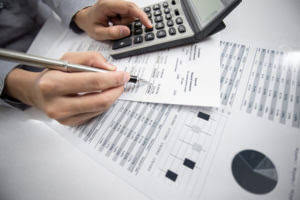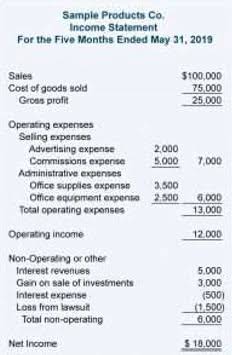What Are Chart of Accounts? How It Works, Setting up & Pros

Every transaction affects at least two accounts – one gets debited and another credited. Double-entry bookkeeping is a fundamental requirement for recording financial transactions under GAAP (Generally Accepted Accounting Principles), so you can’t record your https://www.bookstime.com/ transactions differently. Meanwhile, let’s look at the general ledger real quick because general ledger uses the accounts listed in the chart of accounts to record and organize financial transactions. The chart of accounts, at this point, serves as a structure under which the general ledger operates. In accounting and bookkeeping, we use the term accounts for categories under which you typically record your business’s financial activities.

Sign up for latest finance stories

Examples of expense accounts include the cost of goods sold (COGS), depreciation expense, utility expense, and wages expense. Profits are generated from the sale of assets outside the company’s regular business operations. Revenue accounts record the revenue generated by the entity from revenue-generating operations. These are typically broken down into operating and non-operating revenue. Each COA typically features an identification code, name, and brief description to facilitate the quick location of specific accounts. Businesses can adjust their COAs to reflect their size and examples of chart of accounts nature so the tool remains relevant and useful.
How to Set Up a Chart of Accounts?
When allocating account codes (chart of accounts numbers) don’t forget to leave space for additional accounts and codes to be inserted in a group at a later stage. For example the inventory codes run from 400 to 499 so there is plenty of room to incorporate new categories of inventory if needed. A chart of accounts is a tool that lists all the accounts in the general ledger with unique numbering to help locate them in the relevant accounting book. Stakeholders can refer to the COA and balance sheet, and income statement to find the source of expense and earnings. Initially, a company needs to decide the structure of its COA, the account types and the numbering pattern. If the firm wants to include all the expenses to provide a complete understanding of where it is spending the finances, it can customize its COA.
- Most businesses will find that numerical codes that are three to five digits long will provide a good balance of information.
- Transaction Matching automates the matching of transactions across various data sources, aligning line-level transactions efficiently.
- We often call the assets, liabiliies and equity accounts the balance sheet accounts, as they participate in forming a company’s balance sheet.
- For example, “cash receivables” will be mentioned under the type of asset.
- As mentioned, besides the standard five accounts, the chart of accounts may contain additional accounts, created for the sake of more granularity or to cater to a business’s particular needs.
Research and Development Amortization: Understanding R&D Expenses for Tax Purposes
It helps categorize all transactions so they can be referenced quickly and easily. Like we said above, accounting software can actually generate a chart of accounts for you, which is very convenient. The best accounting software will also use the information in your chart of accounts to automatically generate financial reports, so you can make evidence-based decisions. A chart of accounts also supports better financial reporting, improving both the accuracy and specificity of business reports.
This makes it easier to find information and ensures that everyone in the business records transactions similarly. The difference is that most businesses will have many more types of accounts than your average individual, and so it will look more complex; however, the function and the concept are the same. Essentially, the chart of accounts should give anyone who is looking at it a rough idea of the nature of your business by listing all the accounts involved in your company’s day-to-day operations. For example, a company may decide to code assets from 100 to 199, liabilities from 200 to 299, equity from 300 to 399, and so forth.
Why is chart of accounts important for efficient finance management?
You must use Independent validation only for theAccounting Key Flexfield value sets. Other validations prevent youfrom using the full chart of accounts functionality, such as datasecurity, reporting, and account hierarchy integration. This figure illustrates the main components in thechart of account structure and the way they fit together. https://x.com/BooksTimeInc Segments are securedby security rules and accounts are secured by cross validation rules.


All these asset accounts fall into either current or non-current assets. If you remember those large accounting books of old times where you would write all the transactions, like how much you sold, earned, spent, and so on – that’s what the general ledger is. The only difference is that today, you don’t need pen and paper (or quill and paper, though I like that idea) and use accounting software (or any other electronic means of accounting) to do your books. Expense accounts allow you to keep track of money that you no longer have, and represents any money that you’ve spent. For example, if you rent, the money will move from your cash account to a rent expense account. In this article you will learn about the importance of a chart of accounts and how to create one to keep track of your business’s accounts.
Operating Revenue Accounts
- Liabilities are the claims others have against the company, representing the company’s obligations to others.
- The chart of accounts lists the accounts that are available for recording transactions.
- The chart of accounts organizes your business’ financial accounts into easy-to-understand groups.
- The articles and research support materials available on this site are educational and are not intended to be investment or tax advice.
- This consistency should extend across all accounts to ensure that the data is comparable and reliable.
A well-structured chart of accounts (COA) facilitates precise financial reporting and enables organizations to make informed decisions. Ensuring COA accuracy entails having a system that is scalable, provides granular visibility and streamlines data recording. HighRadius’ Record to Report (R2R) solutions provide organizations with end-to-end capabilities to streamline and automate various accounting processes and achieve 95% journal posting automation. Understanding the chart of accounts (COA) is important for anyone involved in business finances.
- A chart of accounts is a tool that lists all the accounts in the general ledger with unique numbering to help locate them in the relevant accounting book.
- Angela Boxwell, MAAT, brings over 30 years of experience in accounting and finance.
- A chart of accounts lists down all accounts used by an entity in its accounting system.
- To check what information is needed, look at previous code details, which should help.
- Depending on the size of an organization, a firm can have multiple entries for expenses and income in an accounting year.
- The chart of accounts forms the foundation upon which the financial reports are built.
From there, you can get even more detailed, further categorizing items by their business function, company divisions, product and service lines, and more. Therefore, while every COA uses the same building blocks – balance sheet and income statement accounts – how deep you delve into each of those blocks is up to you. The purpose of the code is simply to group similar accounts together, and to provide an easy method of referring to an account when preparing journal entries.
